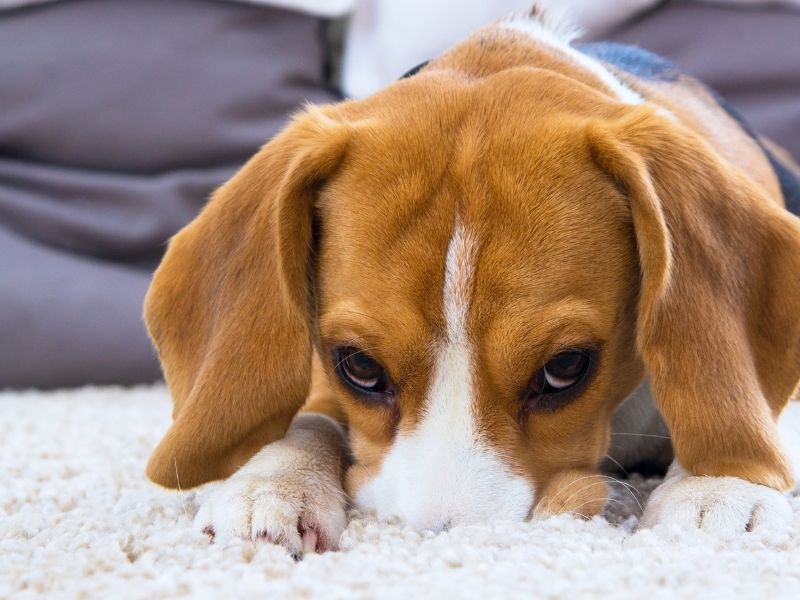
How to Stop a Dog from Marking in the House for Good
This post may include affiliate links. Please read my disclosure policy.
Urine marking is a common behavior, particularly in male dogs. Dogs mark with their urine to assert ownership of objects and areas, leaving a scent message for other dogs. Female dogs mark with their urine too, especially during their heat cycle. This natural behavior is a way for dogs to communicate and establish social hierarchy.
What’s the Difference Between Peeing and Marking?
Your dog may pee inside if they haven’t been let out enough, if they have a small bladder, or for many other reasons. But the peeing will result in a full puddle of urine.
Whereas, in marking, you’ll only find a small amount of urine, and it’s often found on the same spot or object.
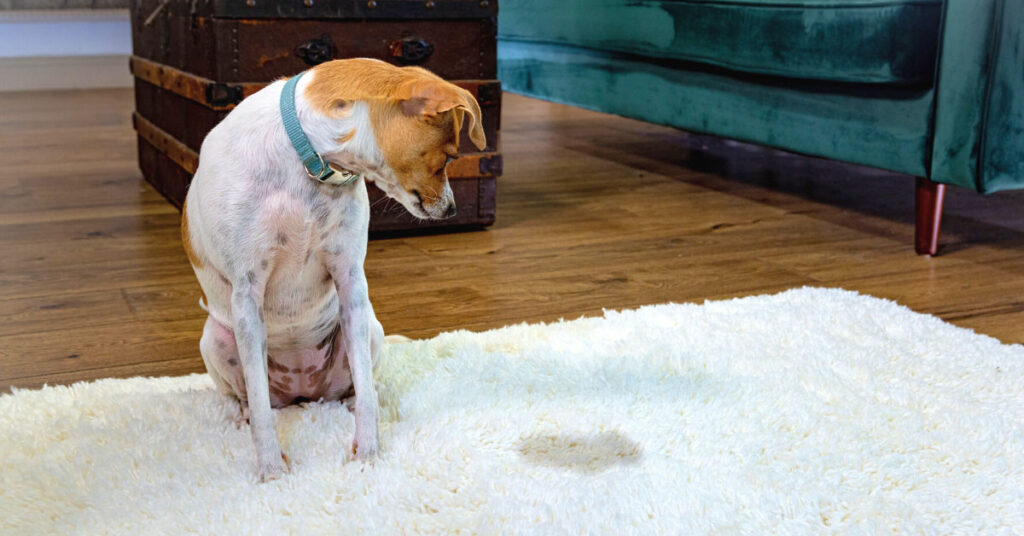
It’s considered natural behavior when dogs mark a certain spot, but it’s certainly not acceptable in the house. Furniture, floors, walls, and other items are ruined or damaged when your dog decides to claim them as his own.
Urine marking is not the result of faulty housebreaking. In fact, most of the time, urine marking can be curbed with behavior modification.
Why Is Your Dog Marking in Your House?
One of the most common reasons dogs start urine marking inside your home is the addition of anything or anyone new, be it a new dog or cat, a baby, a new partner, or even new furniture. This behavior can be particularly prevalent in multi-dog households where there’s competition for resources, attention, or status. By territory marking, a dog is basically saying, “This is my space. Keep out.”
Other triggers may be stress, like moving to a new home or even a change in your and your pup’s routine. Certain forms of anxiety, like separation anxiety, can also cause this behavior. Dogs urine mark as a coping mechanism, providing them with a sense of security and familiarity in response to perceived threats or changes.
If your dog urinates more frequently in your home, this may also indicate underlying health issues. Certain diseases may result in increased urination, which can be misconstrued as marking behavior.
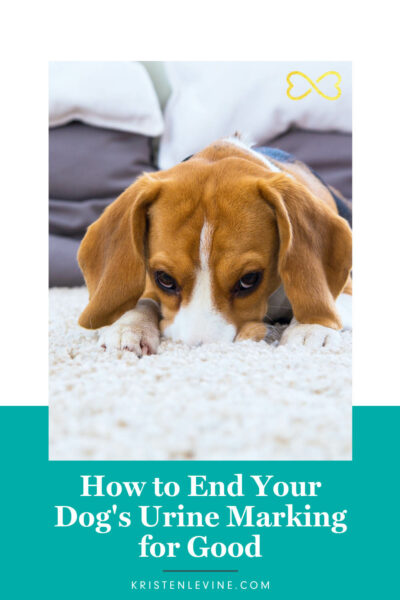
How to Stop Dog Marking in the House
Spay or Neuter Your Dog
For both female dogs and male dogs, spaying or neutering will reduce or stop marking behavior. According to the North American Veterinary Community, as many as 50% of male dogs stop scent marking, or at least do it significantly less often, after being neutered.
Intact male dogs usually begin marking when they start to reach sexual maturity.
If you have a puppy, neutering him as soon as he’s old enough is one of the best ways to stop indoor marking from starting in the first place.
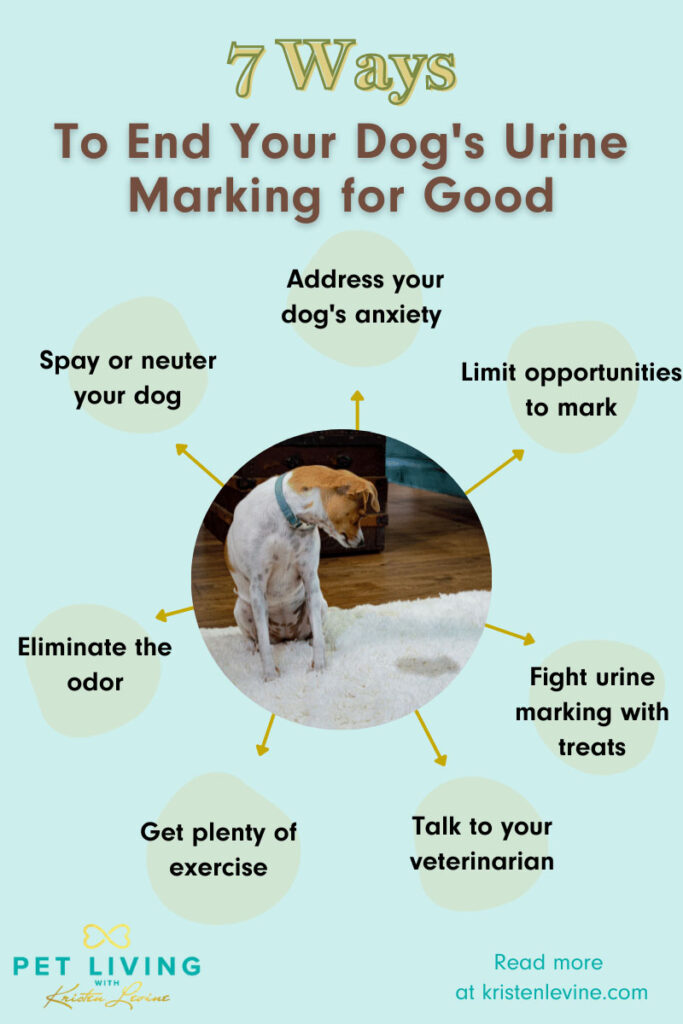
However, it may be days or even weeks for the urine marking behavior to stop after your dog is altered since hormones gradually decline rather than come to a screeching halt.
And it will likely also take some additional house training on your part to change the marking behavior if it has become a deeply ingrained habit.
If your male dog is peeing in the house weeks or months after he’s altered and after you’ve taken the steps below, there could be other behavioral or physical issues that need to be addressed.
Address Your Dog’s Anxiety
If your dog’s marking is caused by something like separation anxiety, you’ll want to address it sooner than later, especially since anxiety can escalate as your dog ages.
This is one reason why it’s important not to yell at your dog when he marks. If he’s doing it out of anxiety, yelling may make it much worse.
Some dogs experience noise anxiety, social anxiety, or separation anxiety. These fears can make a dog react with unwanted behaviors, like urine marking.
There are several OTC (over-the-counter) anxiety tools that can help alleviate your pup’s anxiety. I love this pheromone collar from Adaptil.
My dog, Chilly, had severe anxieties, especially around loud noises, and this collar was a very effective tool we used to manage it. The pheromones have a calming effect on some dogs and can reduce the urge to mark. There is also a room diffuser if you prefer that.
There are also many food-based remedies for calming anxiety, including calming probiotics and calming foods.
Ultimately, if your dog has anxiety, you may need to enlist the help of a veterinary behaviorist to work through it. You can find a behaviorist in your area using this page on the dacvb.org site.
You can also check out my pet anxiety resource page for more information about anxiety signs and solutions.
Eliminate the Odor
As long as the odor from your dog’s urine is still there, he’ll likely continue to mark the same spot. So it’s important to clean it up correctly, with a bio-enzymatic cleaner designed to eliminate biological waste, like urine. Be sure to let these completely dry to eliminate all traces of organic matter.
An enzyme cleaner works by eating the bacteria that’s causing odor and stains. Ordinary household cleaners will do little to eliminate the mess. If you’re in doubt, take a black light to any mess you’ve cleaned without using a bio-enzymatic cleaner, and you’ll be convinced!
Kinderbean No-Stress Mess Eraser is, paws-down, the best cleaner for pet mess, in my opinion. I’ve tested a lot of cleaners, and most have come up short in one way or another.
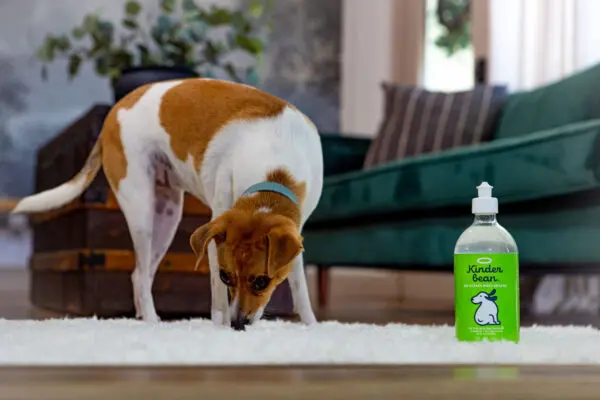
Whichever cleaner you choose, make sure it is:
- Bio-enzymatic
- Safe for pets (both in chemical composition and odor)
- Doesn’t contain harsh dyes that could discolor surfaces
- Contains natural ingredients
- Has a durable dispenser (many have cheap spray tops that break in shipping)
Once you have your cleaner, you need to use it properly to make sure it eliminates the odor.
- Soak up as much urine as possible with a paper towel.
- Saturate the spot with the cleaner. This is important so it can make contact with the urine and eat the bacteria.
- If the spot is horizontal, lay a clean cloth over the top and allow it to set overnight or 12–24 hours. If the spot is vertical, allow the cleaner to air dry.
- Retreat if necessary.
It’s a very simple process, but it’s so important not to simply “spray and wipe away.”
- Enzyme-Powered Cleaner: Simple ingredients, powered by plants. Powerful, bio-enzymatic formula biodegrades odor and stain molecules leaving nothing behind.
- Any Stain, Any Surface: Erases pee, poop, vomit, blood and scoot stains from all floor and furniture surfaces including carpets, upholstery, hard floors and more - even cleans leashes, collars and pet bedding.
- Easy to Use: In just three steps, this ready-to-use cleaning formula will erase messy stains and odors for good - no mixing, just shake and go.
- Safe for Pets & the Earth: Our non-toxic blend of safe probiotics and naturally occurring enzymes have no harsh chemicals, no scary additives, no residue and no possibility of harm to your family or pets.
- Created by a Pet Expert: Pet industry veteran and lifelong pet parent Kristen Levine created Kinderbean to make loving pets easier, messes and all.
Fight Urine Marking with Treats
Most dogs won’t pee where they eat. Change the meaning of the place he has marked by leaving treats directly on the spot after cleaning it.
Consistency is key here because as soon as you’ve banished one area as a pee spot, your dog may choose a new area. It may take weeks before your dog realizes the entire house is off-limits to territory marking. But this solution is usually permanent, so it’s worth the wait.
I like to use these treats because they’re low in calories and all-natural. When you’re dog training, you’ll go through a lot of treats, so you don’t want to give them full-size bones or cookies that will pack on unhealthy pounds.
Get Plenty of Exercise, Both in Body and Mind
Breeds known for their high energy or above-normal intelligence are in special need of exercise. Getting out that pent-up physical or mental energy can help calm your dog and avoid behavioral issues, such as marking.
If you’re already walking your dog and he’s still peeing indoors, you may need to step up your game and either walk him longer or take him for a run.
If running doesn’t get you paws-itively excited, try taking your dog to the park for a game of high-intensity fetch. One of my favorite fetch toys is the ChuckIt! Ring Chaser. It allows you to throw a ring-like toy long distances without tiring out your arm. Plus, it bounces and rolls in ways that are really enticing to our energetic pooches!
Brain stimulation is also important, so come up with creative games or tricks to teach your pet. Not only will it give your pup a purpose, it comes with the benefit of increased bonding time with you!
Exercise may seem like a very simple step, but it’s probably one of the most important!
Limit Opportunities to Mark
If your dog is a stubborn marker, you may need to take stricter measures to curb the behavior.
Some experts recommend the umbilical cord method. When your dog is inside, he’ll remain leashed to you so you can closely monitor him. As his behavior improves, you can gradually give him more freedom to explore the house.
I’ve tried this method to housebreak my dog, Tulip, and it works fantastically. I’ll caution, though, that you do need a lot of patience and consistency to see results.
When to See Your Veterinarian
In most cases, behavior modification is enough to curb your dog’s urine marking. However, in some cases, urine marking can be caused by medical issues.
Your dog may have begun marking because of a urinary tract infection, and the only way to know for sure is to visit your veterinarian.
If your dog has begun marking and there doesn’t seem to be any apparent trigger, it’s time to visit your veterinarian to rule out anything that needs treatment.
Additionally, if your dog has extreme anxiety that’s causing the urine marking, you may need to seek help from a veterinary behaviorist. They can help get your dog the relief he needs and recommend more ways and methods on how to stop a dog from marking in the house.
When Is Urine Marking Acceptable?
When you’re walking your pup, urine marking outdoors should be all right. If you’re in an area where marking would not be acceptable, perhaps like your neighbor’s beloved garden or flower bed, take note of any tell-tale signs that your dog is about to mark, like prolonged sniffing. Lead your pup away from the area by encouraging them to move along (use the voice that you know gets lots of wags) and offer treats if you have any on you.
The Tail End
If your dog is urine marking in the house, rest assured it’s not because he wasn’t house trained enough. Urine marking is a behavior, and with behavioral modification along with neutering your dog, you can stop marking for good.





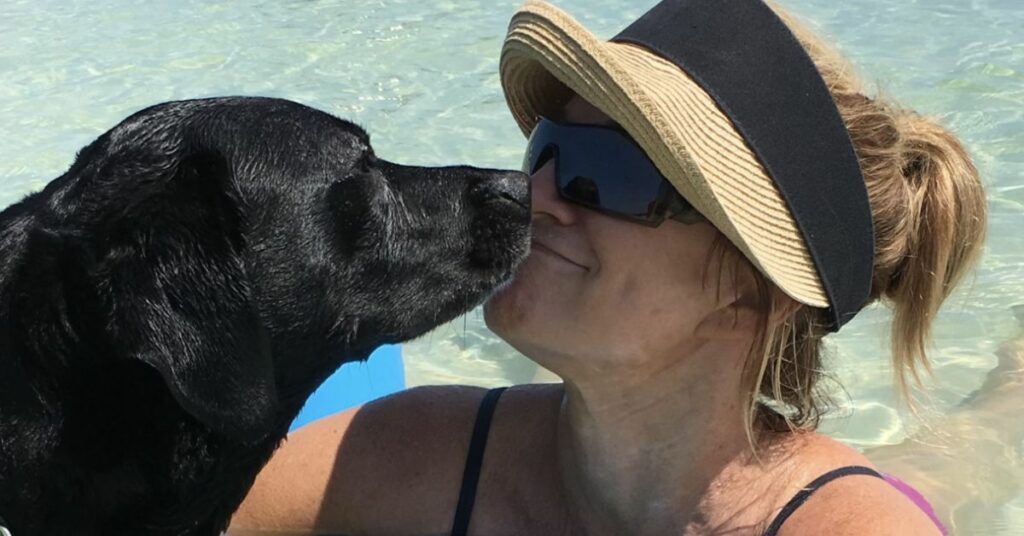
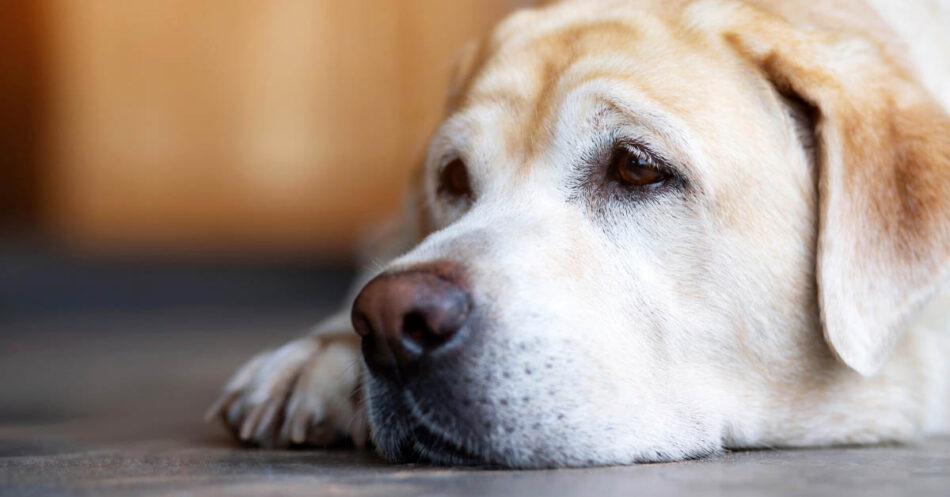
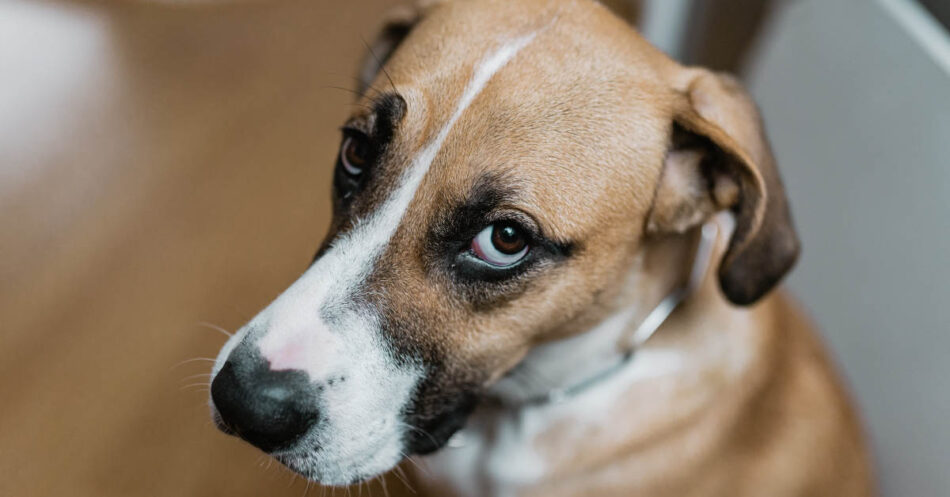
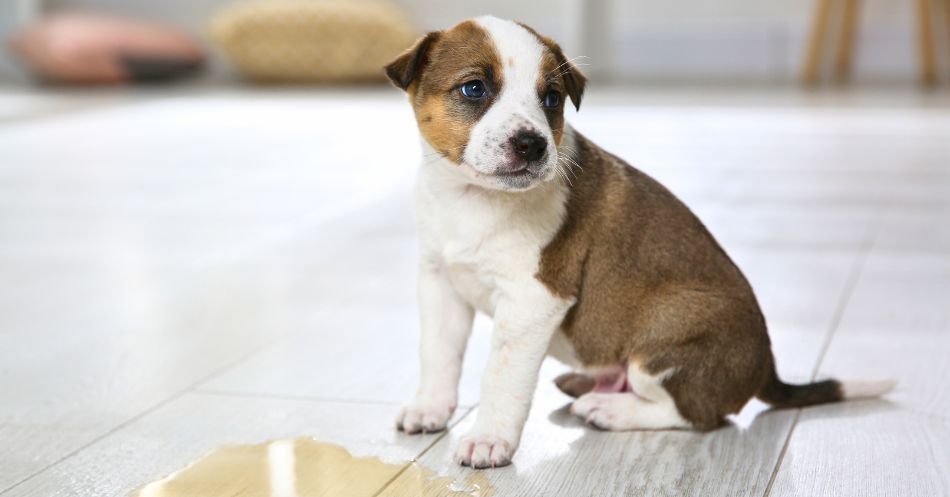
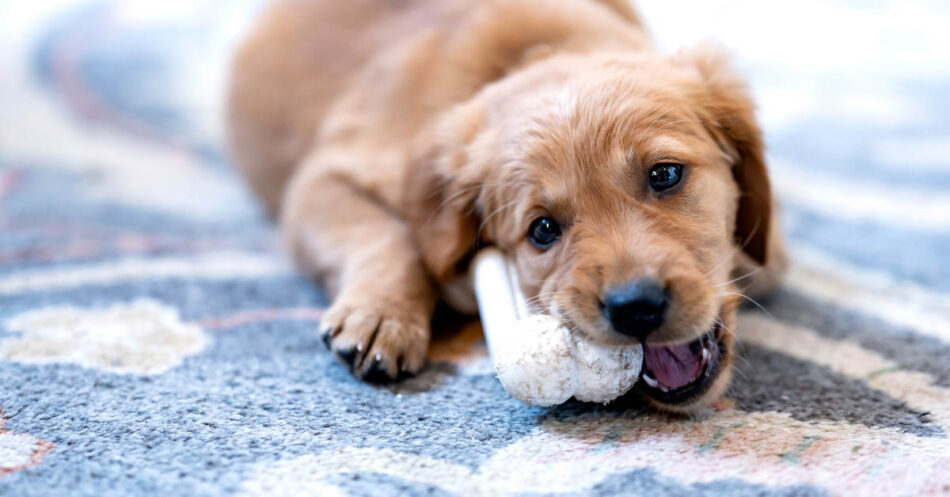
Hi Kristen. I have a 4-5 month old, neutered male that I adopted just over 2 weeks ago. We are working on portly training and the first 7-10 days went great. He had zero accidents. But in the last 7 days, he has peed on my boyfriend’s rug, in his dog bed, and on my couch 3 times. I take him out at least every 3-4 hours and more frequently if I know he’s had a lot of water. He was seen by my vet the day after I adopted him and everything was good. Prior to adopting him, I had another dog who passed away at the beginning of May. So I’m starting to think he is marking his space vs having accidents given he had no accidents in the first 7-10 days of him being with me. So my questions are: which enzymatic cleanser should I use on the couch since it doesn’t have removable cushions? And what do you recommend I do about the marking?
Hi Christina,
Congrats on your newly adopted pup! Let’s get him shaped up on this peeing/marking issue! It’s possible that he’s marking his scent, but I have a feeling this is more of a housebreaking issue. He’s neutered which reduces marking behavior. What is his breed or breed mix? Sometimes smaller breeds/mixes are more difficult to housebreak.
I’m not sure if you’re using a crate or not, but crate training is super helpful as a housebreaking tool. Basically, until you can trust him not to pee in the house, you can’t let him out of your site. When you have to leave the house or if you are busy in the house, you should crate him for short periods of time, say 1-2 hours. Take him out before you put him in and take him out immediately when he comes out of the crate. When you don’t have him in the crate, he should be near by so you can pick up on cues that he’s looking for a place to potty. When that happens, immediately take him outside and praise him/give him a treat when he goes potty outside.
You might also take him back to the vet to determine if he has a urinary infection which could lead to more frequent urination.
As for enzymatic cleaners, there are several that are good, but I exclusively use Unique Pet products. You can find them on Amazon or in some stores. I think I link to them in this article above too. They are safe and effective but you have to read the instructions carefully and follow to the tee!
I hope this is helpful. Keep me posted.
Kristen
Thanks for all the useful information! I have a marking problem with my 2 year old neutered shitzu mix. He came as a puppy and we already had a 10 year old female (spayed) German Shepherd. The shitzu marks occasionally usually at the base of the sofa where I sit or the base of my bed. He has also marked my daughter’s pillows and mine after the housekeeper makes the bed. Super annoying! I am wondering if this behavior will continue once my shepherd is gone? She is very sick and doesn’t have long. The shitzu has always been the alpha of the two.
Hi Kelly,
Yep, you have a frustrating problem indeed!. It’s possible that he will stop marking when your shepherd is gone. (I’m sorry to hear she’s not doing well). He feels the need to mark his territory obviously. Here are a couple of things you might try.
Clean soiled areas super thoroughly using a cleaner specifically designed to eliminate urine odor (I like enzymatic cleaners for this). You may have been doing this already, but if not, make an effort to completely eliminate the odors in case he is marking in those places because he can still smell it from the last time.
Another thing to try, make previously soiled areas unappealing or inaccessible to your dog. Put something around the area to prevent them from getting to it (like a piece of furniture or something). This can be temporary to see if he stops the behavior or he begins to mark somewhere else.
If this isn’t possible, try to change the significance of those marking areas to him. Feed, treat and play with him in the areas where he marks (after you’ve eliminated the odors).
I should also say that it would be a good idea to take him to see your vet about this specific issue to rule out a medical problem or to get a referral to a veterinary behaviorist. They are specially trained in treating, managing, solving pet behavior problems.
I hope this helps Kelly! Keep me posted.
Kristen
Hi.
We adopted a 3-4 year old corgi-pom mix. In the 4 months we’ve had him, he’s had a couple of pee accidents at home and 2 specific occasions of marking. We used the enzyme cleaner and it seems to have done the trick. However, it’s when he is outside that his marking escalates. Any time we let him out to play in the back yard, he has to mark on the fence, different areas every time. When we walk him, 3-4 times a day, he marks constantly. We took him to the dog park for the first time, and more than playing with other dogs, he went around the park, marking every chance he got, and if he saw a dog peeing, he would go over and pee on top of that other dog’s pee spot.
He has marked one person so far, my friend who has 4 cats.
During our walks, I make sure to gently tug him when I notice he is about to mark, but even after doing it repeatedly for 2 months, anytime I forget, he grabs that opportunity and proceeds to mark. I want to be able to leave him with a dog boarder for when we go out for a couple of days, and I’m afraid of him marking there. Or marking when we visit another friends house who has dogs.
Help. Please.
Hi Reshma,
I’m glad the enzyme cleaner worked on the pee accidents in your home. But sorry to hear about his marking problem. Is he neutered yet? If not, having him neutered will go a long way in reducing his marking behavior, along with other health and behavior benefits.
If he is neutered, let me know and I’ll share some other advice.
Thanks for writing:)
Kristen
Hi Kristen, he is neutered.
Hi
I have a fiive year old male Maltese terrirer who is very clever. I have tried to use treats as a tool to reward him when he goes outside to pee, but now he pretends to want to go out so he can get a treat when he comes back in. My problem is he only does a small amount of pee each time so he can go out frequently and get more treats. If I don’t let him out and don’t give him a treat he then goes into another room in the house and has a full blown pee. Can you help?
Hi Carol,
Oh my! He’s a smart little guy! Try letting him out, and treat him when he pees, but then leave him outside a bit longer. If he still has to go, he may “finish his business”. Or, don’t reward him with a treat until he does a “full blown pee”, LOL.
Let me know if that helps.
Kristen
I’m not sure what to do with my unaltered 6 year old female dog. We recently (about a month ago) moved into a new house. The first week was fine, but these last 3 weeks my female dog has been peeing a very small amount at the end of my bed on the floor. She has always slept in the bed with us with our other dog. My husband and I both work during the day with the bedroom door open and she doesn’t come in here and pee during the day while we are gone. Heck she doesn’t even pee anywhere else in the house. I don’t think it would be a UTI since she is able to hold it while we are at work and that’s roughly the same amount of time we are in the bedroom asleep. Any recommendations? I’m about ready to not let her in the bedroom anymore.
Hi Mackenzie,
This is an odd situation. Whenever pets mark, it can be challenging to figure out why.
It’s possible that since you’ve moved, she feels some desire to mark her territory. Or, it could be the result of her experiencing some anxiety.
In either case, I would talk to your vet about this to rule out any medical issues.
One other thing you might try is a pheromone collar. Adaptil makes a good one. This collar has pheromones that mimic the natural ones mother dog’s produce when nursing, so it calms dogs. So, if her marking is anxiety related, this may help.
Lastly, if you get her spayed, this could reduce or eliminate the behavior.
I hope this is helpful!
Kristen
Hello, I have a 10 yr old min-pin and an 8 yr old female chihuahua, both dogs intact. My min-pin has a huge issue with anything plastic, along with couches and tables. I’ve tried spot cleaners, carpet cleaners, catching him while doing it, almost everything under the sun. I think it could be that he can see people and dogs walking by outside through a window, but I’m not sure. He’s ruined many rugs, carpet spots, shoes, tables, curtains, and boxes. Please help!!
Hi Katelyn,
I’m sorry you’re having this problem with your min-pin! There are several reasons why he may be marking but my first piece of advice would be to have him neutered. Neutered males are less likely to mark territory and there’s a greater chance of testicular cancer in intact male dog.
If you can’t or don’t want to get him fixed, I would talk to your vet about what you can do to modify his behavior.
I hope this is helpful.
Kristen
Hello, I have a 10 year old neutered Bichon Frise who has started marking everything in the last year. Some of his favorite places are a bench in our living room and the door frames of our bedrooms. We have tried belly bands and he will just lift his leg to mark and pee with it on. We have other pets in the home, all neutered/ spayed- 2 female dogs and a male cat. None of them are recent additions. Help me!
Hi Taryn,
I believe you indicate that this is a relatively new behavior for your Bichon, right? And it sounds like nothing has really changed to make him start marking, right?
I would take him to the vet to see if there’s some underlying medical issue that could be causing him to mark.
Another thought is that since he’s getting older, he could have some onset of CDS (cognitive dysfunction syndrome). It’s kind of like a doggie dementia. Or, the marking could be the result of him feeling anxious — perhaps just aging related anxiety.
If either of the above are the case, you can try feeding him Bright Minds by Purina. This is a food formulated for brain health for aging dogs. Or, if it’s anxiety, you might try a pheromone collar like the one Adaptil makes.
I know how frustrating this must be. I hope the above is helpful. Keep me posted!
Kristen
Hello. I have 2 male Havenese that are 6 years old. They are half brothers and we purchased them at about 6 weeks old. They both have been marking in the house for the past 6 years. Mostly pee, sometimes poop. How can I stop this craziness? Please help.
Oh btw, they are neutered.
Hi Jane,
Gosh,that’s a frustrating problem! They’ve been doing it for a long time, as you explain, so it may be difficult to change their behavior without talking to your veterinarian or a veterinary behaviorist. There could be a medical issue causing the behavior.
Also, some neutered male dogs mark due to stress. You might try getting them an Adaptil pheromone collar. It calms dogs naturally by mimicking a hormone that mother dogs produce to calm their pups.
I hope this helps. Keep me posted.
Kristen
Hi Kristin – I stumbled across your site – it seems you have a great deal of insight into the problems people are having with their fur friends. My son recently adopted a red tick beagle (1 1/2 – 2 years old… we adopted a bagle from the same rescue 2 years ago) The dogs get along great and the first week my son’s new guy didn’t have any problems. My son said every now and then he would attempt to lift his leg in the kitchen but my son caught him and immediately took him outside. He was at our house at urinated on an upholstered stool (that my daughter’s cats have used as a clawing post… so I cleaned the carpeted area immediately and threw the stool away). We have been reading up on how to help this little guy (was raised as a hunting dog from another state (as most of these rescues were) – we’re trying to get him on a schedule and have used belly bands/wraps which deterred him from urinating in the house and waited until he went outdoors. Problem… today out of nowhere he urinated in the belly band (we’ve had him 3 weeks) We took it off, and put a new one on… and he did it again a short while later. He used to lift his leg to pee… but our male dog has taught him “squatting” is much easier (grrr) so we had no clue he had gone. He is a drinker – so we know to restrict fluid 2 hours before bed…oh btw he was neutered a week before we got him and the stitches were removed by our vet last week. He is a lovey… happy, playful, etc. It’s the urinating that has us twisted. I read to leave the fur friend in the wet band as they don’t like the feel… but we need help. We can’t find any obedience classes that begin before August (due to the pandemic) – any advice would be greatly appreciated. We will schedule an appt with our vet to rule out health issues next week… but any answers in the meantime is a perk!!!!! Thx so much for listening!!!!
Hi Liz!
Gosh, I can feel your frustration! Your son’s dog may have lived his early days in a kennel or outdoor enclosure if he was a hunting dog. And he may have just become accustomed to “weeing” wherever he wanted.
I’m merely guessing here — but it sounds like this marking is his “normal” behavior.
I think the belly band is good for you — as it protects your floors and furnishings, but I don’t think leaving him in it will teach him anything. I don’t believe a dog can use logic to understand that if he doesn’t like a wet belly band, he shouldn’t pee in it! LOL.
Yes, talk to the vet first to rule out a medical issue. The next thing I would do is talk to a veterinary behaviorist. They specialize in understanding dog behavior and they can meet with you virtually (phone or teleconference) to advise you what kind of training or trainer or behavior modification you should employ.
There are only 80 vet behaviorist in the US, so go here to find one near you.
I believe you can retrain him, but it may take some time and patience!
Thank you for reaching out. I hope this is helpful. Please keep me posted.
Kristen
Hi Kristen… Thank you for getting back to me. Since I wrote, my son’s little guy has been to the vet – who found he had a UTI. He was on antibiotics, was much better re: pee-ing, so we became hopeful. Then he pee’d on a chair… He and my son went back to the vet’s who found his UTI hadn’t completely cleared and as such put him on another course of antibiotics. He has been much better and we are careful to look for “signs” that he needs to go outside, and he is on a defined schedule re: food, walks, and going outdoors to do his “business.” I’ve read quite a few of the messages from the other individuals struggling with the same problem, and I agree that as he was previously a hunter he never fully learned “house rules.” I will check into the collar and we have stopped using belly bands (though I breathe much better when he’s wearing one – they aren’t a permanent solution which you shared/explained). 2 things – even though he is better… I am having trust issues although my son has learned to trust him and has given him more room (gradually). I find when he is at our house if my son isn’t watching him 24/7 I find myself becoming increasingly anxious. 2nd thing is the suggestion of crating… my son bought a crate for his apartment and one for our home. I have never “crated” before and have no clue how to do it without feeling I’m punishing him for something. Can you recommend a good guide book or website that could help us with this? Additionally any information you can share re: inappropriate pee-ing would be greatly appreciated!! Finding your site, reading your response, and reading all the other messages from confused owners is extremely helpful… I can’t thank you enough!!!!
Hi Liz,
It can definitely feel challenging to trust again after a repeat offense! Since he had a UTI, that definitely explains the behavior of marking. Since he has had that cleared up, the marking should hopefully come to an end! Crating can be added to his daily routine at nighttime or when you will be gone for long periods of time. You can put toys, a dog bed, treats, etc. inside of the crate to make him feel more comfortable! Introducing that to his routine can take some time, but since he is still young he will likely adapt fairly quickly. If you interested in other resources, I highly recommend completing The Dog Nerds certified training courses. They offer insight from dog training experts to help train your dog with science based solutions! I hope this helps 🙂
Kristen
Hi Liz!
I can’t tell you how happy it makes me to hear your kind words and most importantly, that I may have helped your situation! It’s very common (as you’re read) and not easy to resolve. So, I’m delighted to hear that your son’s pup is getting help for his UTI and the weeing situation is getting better.
As for crating, it’s a great tool when used correctly. I’ll point you to some good crate training resources, but essentially, you want a crate that is just large enough for the dog to lay down comfortably, stand up and turn around comfortably. Dogs won’t soil their “den” area. The crate is their den, If it’s too big, the dog might soil one end of the crate because he has enough room to get away from it. If the crate is too small, they may be cramped or feel anxious.
Next, the crate should never be used as a punishment. When you put the dog in the crate, make it a positive experience, Give them a favorite treat when they go in. Very important — make sure to let him go outside to potty BEFORE you put him in the crate and immediately after letting him out of the crate. Never leave a dog in the crate for longer than they can hold their potty. Most adult dogs can stay in their crate at night 6-8 hours. Younger dogs haven’t developed enough bladder control yet.
You can safely crate the dog for a couple of hours during the day — maybe 1-3 hours. But be sure he is getting enough exercise during the day when not in the crate.
Here’s a good resource.
I hope this is helpful. Keep me posted. You shouldn’t have to feel anxious in your own home about the dog weeing when you least expect it. I think you and your son are on the right track!
Kristen
We recently got a new puppy, our other dog is now marking in the house. How do we stop this?
Hi Chaline,
Your dog may be doing this to mark his territory or because he’s anxious due to the new pup.
I would try to rule out (or in) the anxiety element first. Get something to naturally calm him, like Adaptil — either the room diffuser or the collar (I like the collar best). Adaptil mimics the natural pheromones a mother dog produced to calm her young.
If your dog is urine marking due to anxiety, this should alleviate it. Once he gets used to the puppy you may not need a calming product.
If it’s because he’s marking territory, I recommend you talk to your vet, or even better, a veterinary behaviorist because they can tell you how to curb the behavior through training, behavior modification or in serious problem cases, through mediations.
You can find a vet behaviorist near you here.
I hope this is helpful. It’s such a frustrating problem!
Kristen